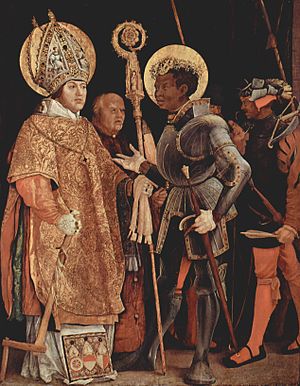art.wikisort.org - Painting
Saint Erasmus and Saint Maurice is an oil on wood painting by German artist Matthias Grünewald. It was commissioned by Albert of Brandenburg, executed between 1520 and 1524, and originally intended for the new cathedral in Halle. It is now held at the Alte Pinakothek in Munich.[1]
| Saint Erasmus and Saint Maurice | |
|---|---|
 | |
| Artist | Matthias Grünewald |
| Year | c. 1520-1524 |
| Type | Oil on wood |
| Dimensions | 226 cm × 176 cm (89 in × 69 in) |
| Location | Alte Pinakothek, Munich |
Description
Saint Erasmus stands proudly, dressed in luxurious episcopal vestments, on the left. He holds in his right hand the testimony of his martyrdom, the spindle wrapped in entrails torn from his body with a ship's winch. Opposite him stands Saint Maurice, believed to have been of black African origin, in a silver armor. He addresses Saint Erasmus by raising his hand clad in a white glove. Maurice, according to the legend, was the leader of the so-called "Thebes Legion", in which only Christian soldiers served. This legion was stationed at Thebes in Egypt and was slain because of their refusal to take part in the persecution of Christians during the reign of Diocletian. Behind St. Erasmus there is a gray-haired abbot, a scholar and an adviser to the archbishop. Behind St. Maurice, there are its hardened soldiers. The poses, movements, clothing, facial expressions and colors of the four figures depicted in the painting brilliantly characterize the various strata of the medieval society. A leader of the clergy in Europe meets a leader of the soldiers in Africa. This, one might say, represents a church-political meeting on the world stage, a testemony of the power and splendor of Catholicism on two continents.[2][3]
Patron
The image of Saint Erasmus actually depicts the commissioner of this painting, known from numerous portraits of that time, Albert of Brandenburg, who was in 1514 the archbishop of Mainz and Magdeburg, and the bishop of Halberstadt. In 1518 he was made a cardinal by Pope Leo X, and later would be chancellor of the Holy Roman Empire, during which tenure he was a fanatical and powerful opponent of the Protestant Reformation. This painting is part of the collection of the Alte Pinakothek in Munich, since his opening in 1836.[4]
References
- Die hll. Erasmus und Mauritius, Alte Pinakothek (German)
- Mattias Grünewald. Meeting of St. Erasmus and St. Maurice (Mattias Grünewald. Der Empfang des Hl. Erasmus durch den Hl. Mauritius), Izi Travel
- The Meeting of Saints Erasmus and Maurice, Black Central Europe
- Die hll. Erasmus und Mauritius, Alte Pinakothek (German)
На других языках
[de] Erasmus-Mauritius-Tafel
Die Erasmus-Mauritius-Tafel ist eines der bedeutendsten Werke Matthias Grünewalds. Es entstand zwischen 1520 und 1524 für die umgestaltete und neu geweihte Neue Stiftskirche bei der fürsterzbischöflichen Residenz in Halle (Saale). Nach der Aufhebung des Stifts im Zuge der Reformation wurde die Tafel zusammen mit anderen Kunstwerken nach Aschaffenburg überführt. Heute befindet sich das Gemälde in der Alten Pinakothek in München.- [en] Saint Erasmus and Saint Maurice
[es] San Erasmo y San Mauricio
Los santos Erasmo y Mauricio (en alemán, Erasmus-Mauritius-Tafel) es uno de los cuadros más conocidos del pintor alemán Matthias Grünewald. Mide 226 cm de alto, y 176 cm. de ancho. Data de la primera mitad de los años 1520. Se encuentra en la Alte Pinakothek de Múnich (Alemania).[ru] Встреча святого Эразма и святого Маврикия
«Встреча святого Эразма и святого Маврикия» — одно из самых значимых произведений Маттиаса Грюневальда, созданное по заказу Альбрехта Бранденбургского в период между 1520 и 1524 годами, и предназначавшееся для нового кафедрального собора в Галле.Другой контент может иметь иную лицензию. Перед использованием материалов сайта WikiSort.org внимательно изучите правила лицензирования конкретных элементов наполнения сайта.
WikiSort.org - проект по пересортировке и дополнению контента Википедии